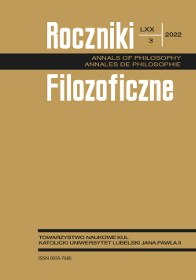Kompasy, mapy i stare bukłaki: kilka uwag o metaforze w narracji naukowej
Compasses, Maps, and Old Wineskins: Some Remarks on the Metaphor in the Scientific Narrative
Author(s): Marcin T. ZdrenkaSubject(s): Philosophy, Ethics / Practical Philosophy, Special Branches of Philosophy, Philosophy of Religion
Published by: Towarzystwo Naukowe KUL & Katolicki Uniwersytet Lubelski Jana Pawła II
Keywords: metaphor; science; philosophy; ethics; scientific style
Summary/Abstract: The article is an invitation to rethink a new and not necessarily original question — the role of metaphor in scientific writing. The immediate pretext is the metaphor of the compass, map, and training, and, in another plan, “old wineskins into which new wine is poured.” These figures are used by Sebastian Gałecki as the culmination of his dissertation Etyka chrześcijańska dla postchrześcijańskiej epoki [Christian Ethics for the Post-Christian Age], confronting the three concepts: ethics of character efficiency (virtue) (Alasdair MacIntyre), conscience (John Henry Newman), and the new theory of natural law (John Finnis). Leaving aside the essence of the content of the dissertation, I try to identify several issues and threats related to the use of metaphors by the authors. In the Umberto Eco terminology, they are regarded as “hot” and methodologically problematic elements of reflection and the way of writing in science. Despite the doubts and reservations about the metaphor as an “unscientific” figure, I would like to defend the right to its correct use in philosophy, especially in ethics. As an example of such use, I consider their use in Sebatian Gałecki’s book.
Journal: Roczniki Filozoficzne
- Issue Year: 70/2022
- Issue No: 3
- Page Range: 449-464
- Page Count: 16
- Language: Polish

